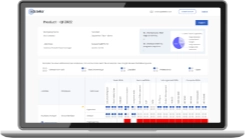
Business analysts play a critical role in translating business requirements into actionable project plans and technical specifications. According to IIBA, jobs related to business analysis are projected to increase by 14% from 2018 to 2028. The roles and responsibilities of business analyst are critical and span various industries including finance, healthcare, retail, education, marketing, agriculture, entertainment and media, human resources, transport and logistics, government and public sector, and e-commerce.
These industries leverage analytics for decision-making, process optimization, customer insights, risk management, and improving operational efficiency.
The role of business analyst expert includes data analysis, requirement documentation, solution evaluation, stakeholder management, and continuous process optimization across various functions. This blog provides appropriate insights into business analyst job description, what does business analysts do, roles and responsibilities of BA, key skills required to be successful, and different roles of business analyst.
What Does a Business Analyst Do?
Business analyst responsibilities for gathering and analyzing business requirements through stakeholders interviews and research defining problems, solution scopes, documenting functional and non-functional requirements. They collaborate with cross-functional teams to identify areas for improvement, propose actionable solutions, and support the implementation of system processes.
Business analysts are proficient in using tools such as SQL, Tableau, Power BI, and Excel, which enables them to extract actionable insights from complex datasets. Not only business analytic tools, they will also have expertise in BI tools such as SAP Business Objects, IBM Cognos to create interactive dashboards and reports. These tools and skills are commonly known by fresher and intermediate business analysts.
Professional technically skilled business analysts are familiar with requirements management platforms such as JIRA, Jama Connect, IBM Doors, Confluence, Balsamiq for prototyping, codeBeamer ALM, Spira Team, and Perforce Helix RM. These platforms aid in tracking, documenting requirements throughout project lifecycles. They often have a solid understanding of system analysis utilizing UML diagrams to represent system functionality and workflows.
One of the business analysts’ extra capabilities to support software testing by writing test cases and facilitating user acceptance testing to ensure solutions meet required business needs. Added to this they have the ability to understand cloud computing, API integration, and data privacy regulations, allowing work scalable solutions and ensuring compliance with security standards.
11 Key Roles and Responsibilities of a Business Analyst
A business analyst job description varies across industries, but in well established organizations, the role is focused on applying core business analysis practices. Research by PMI, shows that business analysts in such environments dedicate about 83% of their time to business analysis activities across diverse projects and programs. With a clear and well-defined scope, the business analyst’s job description emphasizes aligning solutions with strategic objectives making the role essential in driving organizational success.

1. Requirements Collection and Evaluation
Gathering and evaluating business requirements is a core aspect of a business analyst’s role. The business analyst works closely with stakeholders such as department heads, end users, and upper management to understand their needs and document them clearly. This process is critical for defining the scope of the project and ensuring that the resulting solutions meet business objectives.
Once the requirements are collected, the business analyst documents both functional and non-functional requirements. Functional requirements describe what the system should do, while non-functional requirements outline how the system should perform (e.g., speed, security, and scalability). This detailed documentation serves as a guide for both business and IT teams, ensuring everyone is aligned and clear on the expectations for the project.
2. Data Collection and Analysis
Business analysts are also deeply involved in collecting and analyzing data from various sources. Data analysis is a major focus of the business analyst role. For example, if a retail company wants to boost its sales, the analyst job role might involve examining sales data to identify which products are popular during specific times of the year. This analysis helps guide marketing strategies, inventory management, and promotional campaigns, all within the scope of a business analyst job.
A business analyst uses tools like Microsoft Excel, SQL, and Tableau to gather and process data. Excel is great for organizing and manipulating data, while SQL is used for querying databases. Tableau with R is excellent for visualizing data, making it easier to understand trends. More advanced analysts might also use programming languages like Python for complex data analysis. These skills allow a business analyst to convert raw data into actionable insights. Taking time to learn Python training course helps you to learn how to write efficient code, analyze data, and enhance problem-solving abilities, which increases technological prowess in the workplace
Consider a business analyst working with a travel agency. They might analyze customer booking patterns to determine peak travel seasons. This information can help the agency adjust pricing and marketing efforts to maximize revenue. Proficiency in data collection and analysis enables a business analyst to support informed decision-making across the organization.
3. Process Enhancement and Modelling
Improving processes is another critical focus area for business analysts. They map out current business processes using flowcharts or diagrams to visualize how tasks are performed. This activity identifies inefficiencies, bottlenecks, or redundancies, which form a key part of the duties of business analysts in streamlining workflows.
For example, a business analyst might discover that a company’s order processing system involves too many manual steps, leading to delays and errors.
On identifying these inefficiencies, the business analyst develops solutions that align with the company’s objectives. This could involve:
- Recommending technology upgrades.
- Automating repetitive tasks.
- Redesigning workflows for greater efficiency.
Implementing these solutions requires careful management to minimize disruption. For example, if a company decides to automate its order processing, the business analyst must ensure that all staff are trained on the new system to avoid confusion.
The business analyst often collaborates with different teams to gather feedback on proposed changes. This collaboration fosters a sense of ownership among employees, making it easier for the organization to adopt new processes.
Continuous monitoring of these processes is essential to ensure that improvements are practical. In doing so, business analysts drive organizational efficiency and productivity.
4. Stakeholder Management and Communication
Effective communication is crucial for business analysts. The professionals bridge the gap between business teams and IT departments, ensuring that technical solutions align with business needs. For instance, when a marketing team requests a new customer relationship management (CRM) system, the business analyst ensures that the technical specifications reflect business requirements.
This stakeholder management and communication role requires technical knowledge and excellent interpersonal skills. Business analysts facilitate discussions to ensure all parties understand each other’s perspectives. They may need to negotiate compromises when business needs conflict with technical constraints.
For instance, if the marketing team desires specific features that the IT team deems too complex to implement, the business analyst can mediate a discussion to find a feasible solution.
Good stakeholder management keeps everyone informed and engaged throughout the project. Regular updates and feedback loops help maintain transparency and trust. The business analyst must balance business expectations with the technical capabilities of the IT team, ensuring that the project progresses smoothly and meets its objectives. This communication helps in the immediate project and fosters long-term relationships between departments.
5. Solution Implementation and Testing
Once a solution is developed, the Business Analyst often oversees its implementation, which includes creating test plans to ensure the solution works as intended. This is a key responsibility highlighted in many business analyst jobs. For instance, if a new software application is being rolled out, the Business Analyst works closely with the trusted QA vendor to define testing criteria and evaluate whether the application meets the specified requirements.
User Acceptance Testing (UAT) is a critical phase in this process. During UAT, end users test the solution to ensure it meets their needs and expectations. The business analyst coordinates these testing sessions, collects feedback, and makes necessary adjustments based on user input. If users encounter issues, the business analyst must ensure that these are addressed promptly before the solution goes live. Access high-quality UAT training and transform your workforce into a beacon of productivity and efficiency.
Training and documentation are also vital components of this role. The business analyst develops user manuals and training materials to help staff adapt to the new processes or systems. Conducting training sessions ensures that employees are well-prepared and confident in using the new solution.
Even after implementation, a business analyst provides ongoing support, helping resolve any issues that arise and ensuring a smooth transition into the new environment.
6. Gap Analysis
Business analysts are also responsible for comparing current business practices and systems with the desired future state. Identifying these gaps is a crucial part of the analyst job profile, helping business analysts recommend improvements that will propel the company toward its goals. For example, if a company aims to increase its market share, the Business Analyst might assess existing marketing strategies and highlight areas that require enhancement.
Collaboration is key in this process. The business analyst works with technical and non-technical teams to understand current limitations and capabilities. For instance, a gap might involve outdated technology that hinders productivity. Once these gaps are identified, the business analyst collaborates with management to develop a roadmap for closing them. This could involve investing in new technology, streamlining workflows, or providing additional employee training.
Effective gap analysis ensures that organizations remain competitive and can adapt to changing market conditions. By identifying areas for improvement, business analysts help companies stay ahead of potential challenges, enabling them to respond proactively rather than reactively.
7. Risk Management
Risk management is critical in any business project, and business analysts often take the lead in identifying and mitigating potential risks. Having corporate project risk management skills helps you to manage project risks and ensure project success. A business analyst assesses the risks associated with proposed changes, considering factors such as operational disruption, technical feasibility, and stakeholder resistance.
For example, if a company plans to launch a new product, the business analyst might evaluate risks related to production delays or market acceptance.
Creating contingency plans is essential to prepare for unforeseen issues. The business analyst outlines strategies to address these risks, ensuring the organization can react swiftly if problems arise. For instance, identifying a backup supplier earlier can prevent costly production delays if a supplier fails to deliver crucial materials on time.
Effective risk management enhances the chances of project success. Proactively addressing potential problems helps businesses to implement changes more smoothly. This forward-thinking approach minimizes setbacks and boosts confidence among stakeholders, knowing that risks are being managed thoughtfully. Indeed, a culture of risk awareness encourages teams to make informed decisions, leading to better outcomes overall.
8. Creating Functional Specifications
Drafting functional specifications is a core part of business analyst job duties. These documents provide a detailed description of the system’s functionality, expected outcomes, and technical requirements. Functional specifications act as a blueprint, guiding developers and IT teams to create new systems or improve existing ones. This is a central aspect of the duties of a business analyst, as outlined in many business analyst roles and responsibilities.
Clear functional specifications prevent misunderstandings and costly mistakes. They ensure everyone involved understands what is required, reducing the likelihood of rework or delays. For example, if a business analyst specifies that a new e-commerce platform must support multiple payment methods, the developers can design the system accordingly from the outset.
Maintaining clear documentation throughout the development process is crucial. The business analyst serves as a reference point for technical and non-technical stakeholders, ensuring that the project remains aligned with business goals.
This clarity helps prevent scope creep, where unplanned features are added without proper evaluation, potentially derailing the project timeline and budget. Ultimately, thorough functional specifications lay the groundwork for successful project delivery.
9. Training and Support
After implementing new systems or processes, business analysts play a crucial role in training staff. This responsibility involves developing the training needs of employees, conducting workshops, and ensuring employees understand how to use the new systems effectively. For instance, if a company introduces a new project management tool, the business analyst will create user guides and organize training sessions to help staff become familiar with the software.
Ongoing support post-implementation is equally crucial. Business analysts help resolve any issues that arise after the rollout, ensuring a smooth transition into the new environment. This support might involve answering questions, troubleshooting problems, or providing additional training as needed.
Effectual training is essential to the success of any new system. Without proper training, even the most advanced technologies can fail if users don’t know how to work with them. Business analysts ensure that teams are well-prepared, leading to higher adoption rates and improved productivity. Ultimately, the business analyst’s commitment to training and support enhances the overall success of the organization’s new initiatives.
10. Continuous Improvement
Finally, business analysts are key advocates for continuous improvement within the organization. Their work doesn’t stop once a project is completed. They actively monitor implemented solutions, gathering feedback from users and stakeholders to identify further areas for optimization. For example, a business analyst might track the performance of a newly implemented CRM system to determine if it meets user needs and enhances efficiency.
Cultivating a culture of continuous improvement encourages organizations to adapt to changing market conditions and customer needs. Business analysts work with teams to analyze performance data and gather user feedback, identifying opportunities for further enhancements. This ongoing cycle of improvement helps businesses stay competitive and agile.
Additionally, a business analyst may facilitate regular review sessions to discuss progress and identify challenges. Remarkably, creating an environment that values feedback and adaptability helps business analysts contribute to long-term success. This commitment to continuous improvement ensures that organizations can proactively address issues, making necessary adjustments before minor problems escalate into larger challenges.
11. Change Management Facilitation
Facilitating change management within an organization is one of the often overlooked responsibilities of a business analyst. Once new systems, processes, or strategies are implemented, businesses encounter resistance from employees. People are naturally wary of change, especially if it disrupts their usual workflows or demands new skills. This is where the business analyst steps in, acting as a key player in guiding the organization through these transitions.
Facilitating change via effective communication and management involves preparing, equipping, and supporting individuals to adopt change successfully. The business analyst plays a critical role in ensuring that employees understand the reasons for the change, how it will benefit them, and how they can adapt to it smoothly. They create communication plans to keep staff informed and involved, providing regular updates highlighting the progress and value of the changes.
For example, if a company is transitioning from a manual inventory system to an automated one, the business analyst might organize workshops to explain the benefits of the new system, such as reduced errors and faster processing times. They also listen to employee concerns and address them, whether through additional training or system adjustments.
Additionally, the business analyst works with management to develop strategies that minimize disruptions. This could involve phasing in new systems gradually, allowing employees to adjust in stages rather than all at once. Monitoring employee feedback during the implementation phase helps the business analyst identify areas where further support or training may be needed.
Ultimately, change management, though challenging, is a vital aspect of the business analyst’s role in ensuring the long-term success of any initiative.
Key Skills Required for a Business Analyst
Various Types of Business Analyst Roles
The role of business analyst differs across various industries and organizations, often depending on the specific project or business needs. These are critical roles of business analysts that impact industries such as finance, healthcare, information technology, manufacturing, retail, government, and marketing.
Business Process Analyst
The business process analyst job responsibilities emphasizes using process mapping and automation tools to streamline workflows and enhance operational efficiency. At the next level of their career, they typically transition into process architecture or enterprise transformation roles.
Business Systems Analyst
The business systems analyst job responsibilities involve evaluating system integrations, configuring applications, and aligning IT solutions with business requirements. As their responsibilities progress, they often move toward solution architecture or IT strategy leadership.
Data Analyst
The job description of data analyst focuses on applying statistical methods, query languages like SQL, and visualization tools to deliver actionable insights. In the future scope of this role, many advance into data science or machine learning engineering.
IT Business Analyst
The IT business analyst duties highlight translating functional requirements into technical specifications and coordinating with development teams to implement solutions. Over time, the evolution of this role can lead toward IT program management or enterprise architecture.
Product Owner / Product Analyst
The product owner responsibilities require working with product roadmaps, backlog management tools, and feedback systems to guide feature development. The logical next step for this role is growth into product management or portfolio leadership.
Business Intelligence Analyst
The business intelligence analyst responsibilities centers on building dashboards, developing data models, and applying BI tools to support strategic decision-making. As a natural progression, they often transition into analytics leadership or enterprise data strategy roles.
Agile Business Analyst
Agile business analyst responsibilities emphasize on defining user stories, managing product backlogs, and working within iterative development cycles. As they advance, the typical career path expands into Agile coaching or product leadership positions.
Financial Analyst
The job description of financial analyst includes performing financial modeling, variance analysis, and forecasting using specialized financial software. The next stage of this role often leads to corporate finance leadership or investment strategy advisory.
Marketing Analyst
Marketing analyst duties leverage analytics platforms, A/B testing, and data modeling to assess campaign performance and consumer trends. In terms of career growth, they frequently progress into marketing strategy or consumer insights leadership.
Healthcare Business Analyst
The healthcare business analyst career path relies on clinical data analysis, electronic health record systems, and compliance standards to improve healthcare delivery. With career advancement, they typically move into healthcare IT consulting or health informatics leadership.
Requirements Engineer
The job description of requirements engineer focuses on creating detailed requirement specifications, applying modeling techniques, and ensuring traceability through requirement management tools. As their role develops further, they often transition to solution architecture or enterprise systems design.
Case Study: Streamlining Financial Systems Integration for Enhanced Business Efficiency
The case study revolves around a finance client in Australia, a major organization with a market capitalization of $4.7 billion. This company sought to enhance its financial systems through integration, aiming to improve market share, operational efficiency, and customer satisfaction.
The Challenge: The client had a legacy core system, over a decade old, which could not be replaced but had to be integrated with three new systems. These new systems were required to improve lending processes and overall customer experience. The legacy system was connected to several internal systems, leading to significant inefficiencies:
- Customer information was duplicated across different systems.
- Manual data entry led to errors and inefficiencies in customer data collection.
- Disparate systems hindered smooth end-to-end processes, resulting in a subpar customer experience.
Approach Taken: Business Analysis (BAPL), with its decade-long experience in organizational efficiency improvement, was tasked with executing the systems integration. BAPL’s role involved:
- Stakeholder Collaboration: Engaging a wide range of internal and external stakeholders to align objectives and gain consensus.
- Vendor Management: Ensuring seamless cooperation between vendors and aligning the integration program with the client’s needs.
- Data-Driven System Design: BAPL employed a detailed analysis of the data within each system, focusing on preserving reporting functionality essential for regulatory and financial requirements.
- Development of Artefacts: BAPL created various critical documents, including Logical Entity Relationship Diagrams, Data Dictionaries, and a canonical model outlining the data flow from source to target systems.
Results: The integration of the financial systems brought about multiple business and operational benefits:
- End-to-End Process Improvement: The integration streamlined processes across the company, improving the overall efficiency of operations.
- Enhanced Data Quality and Reporting: The reduction in duplicated data and errors improved the quality of data, leading to more accurate and efficient reporting.
- Reduced Costs and Risks: Through improved system alignment, the company reduced operational costs and mitigated risks related to data errors.
- Future-Proof Integration: The project set up a solid foundation for future growth, providing a clear vision of data flow and better alignment between business processes and software.
Ultimately, BAPL successfully executed the integration project, delivering a significant improvement in the client’s operational efficiency, data quality, and customer experience.
Preparing for the Role of a Business Analyst for 2026: What You Must Know
In 2026, the business analyst role is evolving beyond traditional boundaries, requiring a mix of technical expertise, strategic thinking, and strong interpersonal skills to meet the challenges of a rapidly changing business landscape. Here are a few pro-tips for professionals preparing for the role.
- Hybrid Skills are Essential: Business analysts in 2026 need to combine domain knowledge with technical skills, like AI, data analytics, and automation, to bridge the gap between business needs and technology solutions.
- Agile is Key: More than ever, business analysts are adopting Agile methodologies. Being comfortable with iterative processes, collaboration across teams, and adapting requirements on the go will set you apart.
- Emotional Intelligence Matters: Technical skills alone won't cut it. Your ability to navigate stakeholder relationships, manage conflicts, and communicate effectively will make or break your projects.
- Sustainability Will Shape Strategy: With increasing focus on sustainability, business analysts will need to evaluate the impact of environmental goals on business operations, from supply chains to energy usage.
- Automation Will Enhance Efficiency: Embrace automation tools to streamline repetitive tasks. This allows you to focus on higher-level analysis and strategic insights.
- Continuous Learning is Non-Negotiable: Keep up with certifications in Agile, data science, and emerging technologies to stay ahead of the curve and ensure your skills remain relevant.
Frequently Asked Questions
Conclusion
The role of business analysts is to evaluate complex business challenges and identify inefficiencies by applying advanced analytical techniques aligned with organizational goals. They facilitate clear communication between stakeholders and technical teams, ensuring requirements are accurately captured and solutions are effectively implemented. By continuously assessing risks and validating outcomes, business analysts drive operational improvements that support strategic growth and sustained competitive advantage.
For any business looking to stay competitive and agile, investing in a strong business analysis team is essential for thriving in the fast-evolving market.
Above all, Edstellar delivers tailored corporate training programs designed to elevate the expertise of business analysts. By leveraging a comprehensive skills matrix, organizations can identify critical skill gaps, craft targeted development plans, and drive impactful talent transformation.
With over 2,000 courses spanning technical, behavioral, management, compliance, social impact, and leadership domains, Edstellar empowers business analysts to excel in complex environments, enabling them to deliver data-driven insights, optimize processes, and align solutions with business objectives. This approach ensures sustained growth, innovation, and a competitive edge for organizations.
Explore High-impact instructor-led training for your teams.
#On-site #Virtual #GroupTraining #Customized

Bridge the Gap Between Learning & Performance
Turn Your Training Programs Into Revenue Drivers.
Schedule a ConsultationEdstellar Training Catalog
Explore 2000+ industry ready instructor-led training programs.

Coaching that Unlocks Potential
Create dynamic leaders and cohesive teams. Learn more now!


Want to evaluate your team’s skill gaps?
Do a quick Skill gap analysis with Edstellar’s Free Skill Matrix tool

Transform Your L&D Strategy Today
Unlock premium resources, tools, and frameworks designed for HR and learning professionals. Our L&D Hub gives you everything needed to elevate your organization's training approach.
Access L&D Hub Resources.svg)
.svg)



.svg)
.svg)
.svg)


.svg)
.svg)
.svg)
.svg)

